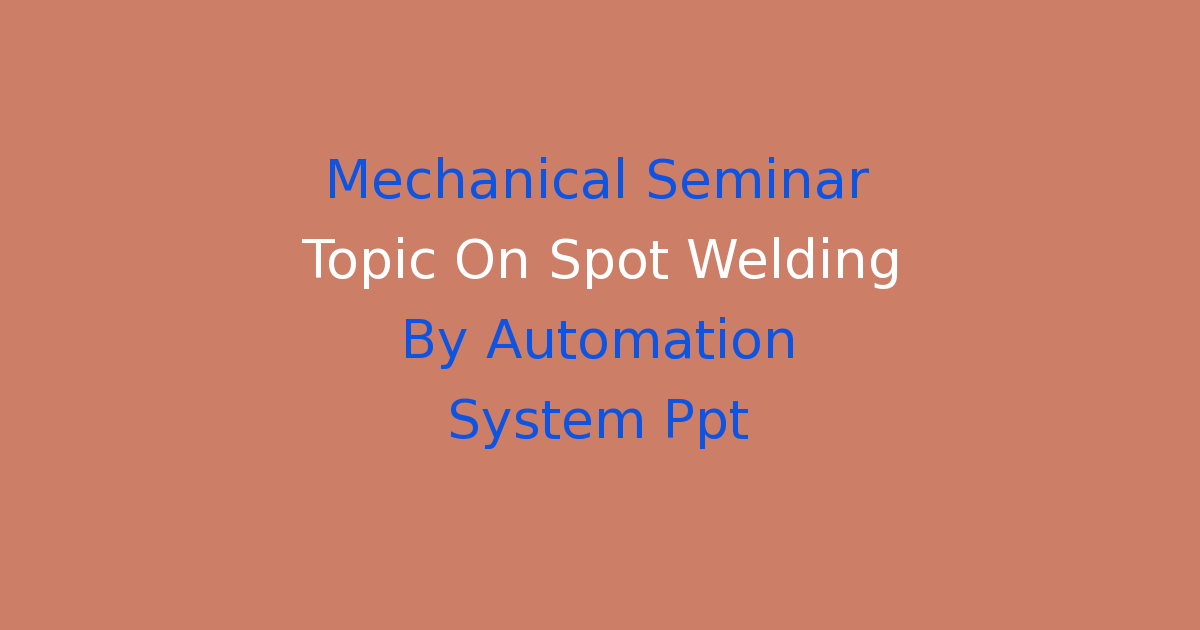Presentation on the automation system for spot welding in a mechanical seminar.
Spot Welding by Automation System PPT
Introduction
Spot welding is a widely used method for joining two or more metal sheets together in various industries such as automotive, aerospace, and electronics. In traditional spot welding processes, operators manually place the parts to be welded on the electrodes, operate the welding machine, and visually inspect the welded joint. This manual process can be time-consuming, labor-intensive, and prone to human error. To address these challenges, automation systems have been developed to automate the spot welding process.
Problem Statement
Although automation systems have improved the efficiency and accuracy of spot welding processes, there are still limitations and challenges that need to be addressed. The existing automation systems rely on pre-programmed robots or machines to perform spot welding, which may not be flexible enough to adapt to different part geometries or welding conditions. Moreover, these systems may lack the intelligence to adjust welding parameters in real-time based on the quality of the weld joint.
Existing System
In the existing system of spot welding by automation, robots or machines are programmed to perform spot welding based on a predetermined set of parameters such as electrode force, welding current, and welding time. The parts to be welded are placed on the electrodes by operators, and the automation system carries out the welding process. However, this system may not be able to handle variations in part geometry or welding conditions, leading to inconsistent weld quality.
Disadvantages
Some of the disadvantages of the existing spot welding automation system include:
- Lack of flexibility to adapt to different part geometries
- Inability to adjust welding parameters in real-time based on weld quality
- Potential for inconsistent weld quality
- Dependence on manual labor for parts placement
- Time-consuming setup and programming
Proposed System
The proposed system for spot welding by automation aims to address the limitations of the existing system by incorporating advanced sensing and control technologies. In the proposed system, sensors are used to monitor the quality of the weld joint in real-time, and the control system adjusts welding parameters accordingly to ensure consistent weld quality. The automation system is also equipped with machine learning algorithms that enable it to learn and adapt to different part geometries and welding conditions.
Advantages
Some of the advantages of the proposed spot welding automation system include:
- Real-time monitoring of weld quality
- Automatic adjustment of welding parameters for consistent weld quality
- Flexibility to adapt to different part geometries
- Reduction of manual labor for parts placement
- Improved efficiency and productivity
Features
The key features of the proposed spot welding automation system include:
- Advanced sensing technologies for real-time monitoring of weld quality
- Machine learning algorithms for adaptive control of welding parameters
- Intuitive user interface for easy programming and operation
- Compatibility with a wide range of part geometries and welding conditions
- Robust construction for durability and reliability
Conclusion
In conclusion, the proposed system for spot welding by automation offers a more efficient, flexible, and intelligent solution for joining metal sheets in various industries. By incorporating advanced sensing and control technologies, the automation system can monitor weld quality in real-time and adjust welding parameters accordingly to ensure consistent and high-quality weld joints. With its intuitive user interface and compatibility with a wide range of part geometries, the proposed system is poised to revolutionize the spot welding process and improve productivity in manufacturing operations.

